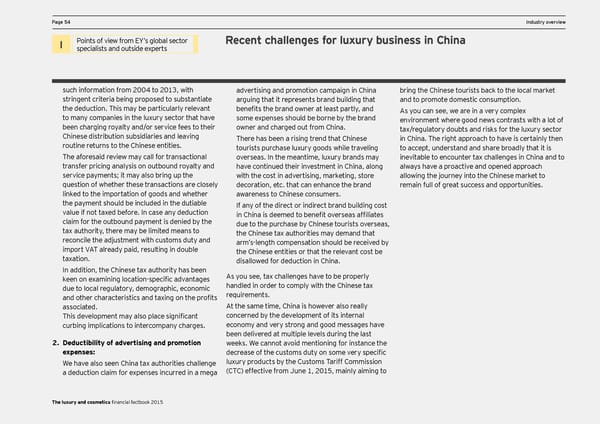PPage 54age 54 DCF and valuation pIndustry oaramevervieterws I Points of view from EY’s global sector Recent challenges for luxury business in China specialists and outside experts such information from 2004 to 2013, with advertising and promotion campaign in China bring the Chinese tourists back to the local market stringent criteria being proposed to substantiate arguing that it represents brand building that and to promote domestic consumption. the deduction. This may be particularly relevant benefits the brand owner at least partly, and As you can see, we are in a very complex to many companies in the luxury sector that have some expenses should be borne by the brand environment where good news contrasts with a lot of been charging royalty and/or service fees to their owner and charged out from China. tax/regulatory doubts and risks for the luxury sector Chinese distribution subsidiaries and leaving There has been a rising trend that Chinese in China. The right approach to have is certainly then routine returns to the Chinese entities. tourists purchase luxury goods while traveling to accept, understand and share broadly that it is The aforesaid review may call for transactional overseas. In the meantime, luxury brands may inevitable to encounter tax challenges in China and to transfer pricing analysis on outbound royalty and have continued their investment in China, along always have a proactive and opened approach service payments; it may also bring up the with the cost in advertising, marketing, store allowing the journey into the Chinese market to question of whether these transactions are closely decoration, etc. that can enhance the brand remain full of great success and opportunities. linked to the importation of goods and whether awareness to Chinese consumers. the payment should be included in the dutiable If any of the direct or indirect brand building cost value if not taxed before. In case any deduction in China is deemed to benefit overseas affiliates claim for the outbound payment is denied by the due to the purchase by Chinese tourists overseas, tax authority, there may be limited means to the Chinese tax authorities may demand that reconcile the adjustment with customs duty and arm’s-length compensation should be received by import VAT already paid, resulting in double the Chinese entities or that the relevant cost be taxation. disallowed for deduction in China. In addition, the Chinese tax authority has been As you see, tax challenges have to be properly keen on examining location-specific advantages handled in order to comply with the Chinese tax due to local regulatory, demographic, economic requirements. and other characteristics and taxing on the profits associated. At the same time, China is however also really This development may also place significant concerned by the development of its internal curbing implications to intercompany charges. economy and very strong and good messages have been delivered at multiple levels during the last 2. Deductibility of advertising and promotion weeks. We cannot avoid mentioning for instance the expenses: decrease of the customs duty on some very specific We have also seen China tax authorities challenge luxury products by the Customs Tariff Commission a deduction claim for expenses incurred in a mega (CTC) effective from June 1, 2015, mainly aiming to The luxury and cosmetics financial factbook 2015
 Seeking sustainable growth - The luxury and cosmetics financial factbook Page 55 Page 57
Seeking sustainable growth - The luxury and cosmetics financial factbook Page 55 Page 57